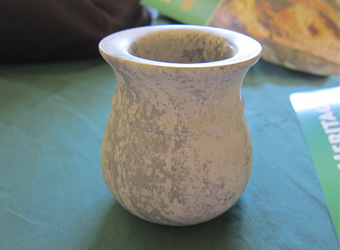#06 We visited the production site that has been supplying us for three years. Vol.2
In this column, we would like to report a little about the region our producers are living in, things to share about making products, and the history, as well as their production.
1.The ceremony of book donation from UK
We successfully donated English books from customers in a MUJI store in London in December 2012 to the library in local producer's facilities. We hope that children in the region will grow up by learning a lot from the books.
 Donated books in a MUJI store in London last year
Donated books in a MUJI store in London last year
 Library and donated books
Library and donated books
 We held a book donation ceremony during our visit this year.
We held a book donation ceremony during our visit this year.
2.Conducting a seminar
We conduct a seminar for producers in Kenya every year. This is intended to share information about achievements and non-achievements in their production, and feed back how products are shipped, packaged, and sold after being made by producers at workshops, and which items and how many were sold.

Through such feedback, producers can learn business - how products are distributed and reach end-consumers. This year, in fact, the leader of producers showed a positive attitude, saying "We'd like to know current design trends and needs in the market."
Meanwhile, one of the producers requested the improvement of their work environment, where producers do work while being covered in powder left when carving soap stones. He said, "We usually work in our casual clothes, but want to work in a uniform like one worn by some of the craftsmen for improved work efficiency."

The producers concluded the seminar with a call like some magical charm.
3.The history of soap stone carving
Soap stone carving has a long history, dating back to about 4000 years ago when people drew rock art on soap stones. It is said that the present form of soap stone carving and its industry started about 300 years ago. In the past, stones used to be shaped and used in daily lives, including pots to store oils or seasonings as shown below, bowls, dishes, and pipes for cigarettes. Today, they are made more for colorful stone products such as ornaments and souvenirs.
Soap stones in this region are also called "Kisii Stones" after the name of the region. This is because they contain different components from those of soap stones mined in other regions in the world and can be mined only in Kissi. Some people say that only a few percent of the known stone reserves have been extracted and the stones have an industrial potential. Soap stone carving allegedly accounts for 40% of handicraft exports from Kenya and involves more than half the local people. It must be a traditional local industry from Kisii in Kenya.
4.Ingenuity for making products without waste
Unlike us who can always buy anything we want, producers in Kenya cannot always get what they want. That is why they make products with as much ingenuity as possible while being friendly to the environment.
1)Tools
Tools for mining stones are files, screws, and tire rubber. The producers have wisdom to create useful tools from what they have with their own ingenuity in an environment where tools are hard to get by.
2)Packing material
Old cardboard boxes are reused with turned inside out as inner or outer cases for shipment. Shredded old newspaper and PC printer waste paper are used for cushioning. Their ingenuity in an environment without things leads to eco-friendly product manufacturing.
Products are once shipped to us in Japan using these old cardboard boxes and cushioning. Then, they are inspected and re-packaged in MUJI's packaging boxes.

3)Powder left from soap stone
Powder is left when carving soap stones. This can be reused for raw material of chalk or wall material mixed with cow dung.
5.Hospitality in Kenya
Every time we visited our producers in Kenya in the last three years, we were made happy with their friendly attitude saying "Karibu, Karibu (Welcome, Welcome)."
Here is an extra episode of the visit about meals we had with them. They cook together and eat together. The Kisii region has rain, rich vegetation, and many edible berries and fruits to harvest.
 A day starts with coffee with milk.
A day starts with coffee with milk.
Some of the women begin cooking for the group in the morning.
Cooking with a large bowl is done outside using firewood.
 Women are preparing a meal together while chatting.
Women are preparing a meal together while chatting.
 Meals turned out to be delicious.
Meals turned out to be delicious.
 The producers basically serve themselves what they want.
The producers basically serve themselves what they want.
 They eat well with their hand.
They eat well with their hand.
 "Here you go," a lady sometimes offers a meal.
"Here you go," a lady sometimes offers a meal.
Just having lunch with them, we already became fans of Kenyan home-cooked meal.
At the end of lunch, we took a group picture. We hope this year's production will be successfully completed. Their products will be waiting to meet you in stores.















